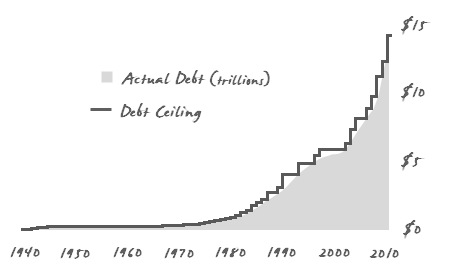It is disconcerting, to say the least, to read headlines referencing a possible “default” by the U.S. on its debt obligations. Congress’s well-publicized standoff on budget cuts and the U.S.’s imminent collision with the debt ceiling have people around the world wondering about the potential consequences, if a deal isn’t reached soon.
For those unfamiliar with the nation’s debt ceiling history, it has almost always been this way—contentious, dramatic, and down-to-the-wire. Since the aggregate debt limit was created back in 1939, it has been lifted almost 100 times.[1] Many of these incidents were preceded by similar political posturing and predictions of financial disaster.
On each of these past occasions, however, a deal was reached to raise the debt limit and pull our government from the brink—often at the eleventh hour. Just as in this instance, The U.S. Treasury has repeatedly been forced to use financial maneuvers to buy time while Congress and the President negotiate a deal. To illustrate just how close we have cut it in the past, consider 1979 when the resolution of the debt limit issue was so late the payment schedule on a portion of short-dated Treasury Bills was missed.[2] The incident was quickly resolved, but technically speaking, represented a default.
Despite the historical drama and confronting “this time is different” scenarios numerous times, the U.S. has enjoyed its coveted AAA credit rating for the past 70 years. Notice from ratings agencies, Standard & Poor’s and Moody’s, on the potential for credit downgrades should provide added incentive for decision makers to reach a deal and make progress towards putting the country’s finances on a stronger footing. One thing participants in this negotiation seem to agree on is the interest rate increase that would result from a credit rating downgrade would make paying down the debt and solving this problem even harder than it is now.
Use of the term “default” as it relates to Treasury Bonds also deserves a little more explanation than it is receiving in some of the press. Some people might worry U.S. Treasury Bond holders will be left with nothing if the debt limit isn’t raised right away. Our inability to issue more debt would not immediately result in existing debt going into default. Actually, U.S. government revenue is still more than 5 ½ times the amount needed to make interest payments. To be sure, the Treasury would have to make some excruciating choices about what to cut, but would likely prioritize interest payments, Social Security, Medicare, and “essential defense” payments over other types of spending.
Markets appear to be anticipating yet another last-minute debt limit deal. Stock and bond prices are actually higher now, as the deadline nears, than they were earlier in the year. The information conveyed by millions of investors with real money at stake is more reliable than the politically charged statements coming out of Washington.
Of course, no one can say with certainty what the short-term future holds. We do believe, however, that a prudent investment strategy should be based—in part—on lessons learned from periods of past turmoil and not based on pure speculation about the future. With that in mind, we continue to believe a diversified portfolio consisting of nearly every publicly-traded stock and real estate investment around the globe, complemented with Treasury bonds issued by the largest and most productive economy in the world, is the most effective protection against uncertainty. That, and a healthy dose of discipline.
1 Kirchgaessner, Stephanie, Richard McGregor and James Politi. “US Debt Crunch: A Nation Taken To The Limit.” Financial Times, July 14, 2011.
2 Ibid.

